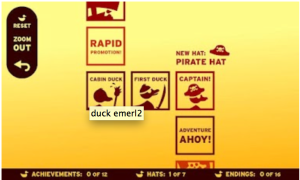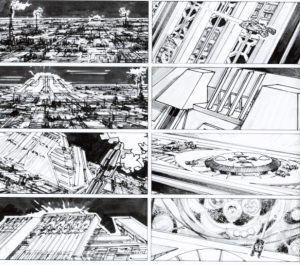Will Eisner, one of the first cartoonists to work in the American Comic Book industry said “the story form is a vehicle for conveying information in an easily absorbed manner.”
Scott Pilgrim began as a series of graphic novels by Bryan Lee O’Malley
When making a movie of it the idea was to keep the spirit of the comic book alive by having special effects similar to the style (and graphics) of comics.
images taken from double negative, the link below contains a bit more detail on the effects and what happened when the director, Edgar Wright, approached double negative.
http://www.dneg.com/projects/scott_pilgrim_vs._the_world_255.html
The Secret – Andrzej Klimowski
This is novel whose narrative exists entirely was a sequence of 300 pages of drawings and photo-montages.
“In The Secret (ISBN 0-571-20688-3, Faber & Faber), Klimowski’s new novel-without-words, his sequence of 300 charged brush and ink drawings questions the act of looking and being looked at, the perception and gaze of characters, narrator, author and reader and the tricks the eye can play on us all. Tellingly, he opens and closes with a single eyeball peering through a peephole or shutter. This image instantly reminded me of Roy Lichtenstein’s 1961 pop art painting, based in turn on a Steve Roper comic strip panel (8/6/61) written by Allen Saunders and drawn by William Overgard. Lichtenstein “appropriates” Saunders’ speech balloon, which says “I Can See The Whole Room!… And There’s Nobody In It!” Klimowski, unconsciously it seems, reappropriates the image back into his comic, while that loaded phrase could almost describe the atmosphere of his silent fable.
The story’s key image and preoccupation is the camera and particularly the camera obscura, Latin for ‘a darkened chamber’ with an aperture, through which images of objects or persons outside can be projected, upside down, onto the opposite wall. “The camera was the image I started with. What I like is that it is such a simple object and yet it can capture a whole world inside it. From there I just let the images flow. Drawing is like falling in love. You just go ahead without knowing what’s going to happen to you.”
the extract above is taken from an article on the book – http://www.paulgravett.com/index.php/articles/article/andrzej_klimowski
Without including words in the novel, he allows for everything to be left open to interpretation, involving the reader in the story -the pictures are more effective without the words explaining everything about them – “In a way what I do is an invitation for the viewer to participate. I leave things open to interpretation,”



Writing for Visual Thinkers: A guide for Artists and Designers.
Storytelling
“How does the word “narrative” relate to both written and visual work? Narrative structures are embedded in a story to help give the story a framework. Narrative moves a person through a story in a pleasurable and compelling fashion. A narrative can be heard, as in a radio play; it can be watched, as in a film; it can be read, as in a novel; it can be danced to, as in a song; and even seen/read, as in a graphic novel. Narrative structures vary depending on the medium and the purpose. A traditional linear narrative structure typically depends on a page-to-page reading for comprehension. A nonlinear narrative allows for the reader to move independently throughout a piece, often creating new meanings from discovering connections. But they all share one important and all so human job: to tell us a story.”
Ted Talks – Scott McCloud
“Scott McCloud bends the presentation format into a cartoon-like experience, where colorful diversions whiz through childhood fascinations and imagined futures that our eyes can hear and touch.”
- comics are a visual medium through which they try to embrace all the senses
- different elements and symbols ( symbols represent sound and it’s texture) are all presented through the visual sense
- hypertext comics – interactivity, inspiration can be taken from those ‘ancient’ comics
- space and time – the basic ideas of comics can be broken when going beyond print, i.e. digital
- the monitor should be seen as a window not a page of a comic, this allows for the idea of an infinite comic, made along all axis and shapes
- durable mutations that would last – adapting continually to their environment.
hyper comics have already been made…
Pup contemplates the heat death of the universe by Drew Wine, this is very cool, I love the visual style of the comic especially when combined with the realism aspects (earth)
http://www.drewweing.com/puppages/13pup.html
Daniel Merlin Goodbrey – A duck has an adventure
“The simple, iconic artwork delivers all the visual information you need, a tap on the panel moves you forwards to the next panel; to adventures, a simple life, an education, and much, much more. Choices happen regularly, and each choice leads you down a different path, even occasionally working your way back to join the progress of another pathway. Mundane reality of a duck’s life swiftly transforms into weirdness and surreal moments whatever path you choose. It’s great fun, a lovely app, and from what limited experience I have of these things, it’s smooth, simple, involving and entertaining.”
Taken from – http://www.forbiddenplanet.co.uk/blog/2012/a-duck-has-an-adventure-daniel-merlin-goodbrey-takes-hypercomics-to-apps/
Ryan Woodward – Bottom of the Ninth
http://www.bottom-of-the-ninth.com
watch a clip here – http://www.bottom-of-the-ninth.com/?page_id=1811
Storyboards are another great way of forming a visual narrative..
storyboards won’t contain any text explaining the plot of the film (mainly explanations of shots and effects needed) – for the film to be easily followed and understood by the audience a huge amount of planning must go into the storyboards, making sure that the narrative is carried successfully throughout the visual plane.
bladerunner
James Cameron’s – Aliens
Psyhco














